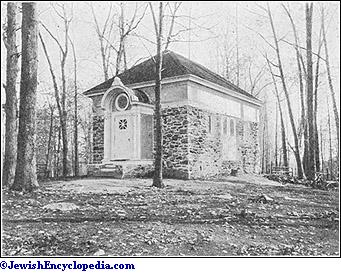I had been wanting to visit the Zweighaft and Sachs mausoleums for a long time, but their locations in Queens made planning a trip from Virginia tricky. The opportunity finally presented itself on our way home from our annual June trip to Hedges Lake in Cambridge, NY.
The name of the Mt. Carmel cemetery was a source of confusion to me. Old family notes refer to the cemetery as Cypress Hills, Hungarian Union Fields section. Mt. Carmel Cemetery now encompasses five sections. The area where the Zweighaft mausoleum is located is called the 'Hungarian Society Section'. Today, Cypress Hills Cemetery is the name of a different cemetery entirely.
Entombed in the Zweighaft mausoleum are the remains of:
- our great grandparents, Simon and Sophia Zweighaft
- two of their children, Bernard (our grandfather) and Helena, along with their
spouses, Blanche Saxe Zweighaft and Adolph Hirschberg
spouses, Blanche Saxe Zweighaft and Adolph Hirschberg
- Helena and Adolph's children, Jane and Leo, along with their spouses,
Seymour London and Jolan Hirschberg
 |
| Entry from scrapbook of Dr. James F.B.Zweighaft, son of Bernard and Blanche |
 |
| Dr. Bernard Zweighaft |
As the historic map in the cemetery office did not correctly identify the mausoleum location, the cemetery foreman tramped around the grounds with us for about an hour before we finally came upon the building, close to where we had started. The foreman retrieved the mausoleum key from the office, and seemed as surprised as we were that they had one. (We actually have a key as well, but forgot to bring it with us! See the April 30, 2012 blog post for an image.). I really didn't expect to be able to enter the building and indeed, the foreman had to use a lubricant to get the old key to work, but after a little jiggling, the door opened. Bernard's was the first death in 1907 at age 41; Leo Hirschberg's the last in 1988 at age 93, so it's probably been 25 years since the mausoleum was accessed.
 |
| Simon and Sophia's crypts beneath stained glass window. |
 |
| Crypts on right. Seymour London is above Jane. Empty on top. |
 |
| Crypts on the left. Two empty crypts on top. |

The mausoleum is a substantial building, measuring about 14' by 12' with a 15' height at its peak. Four polished marble columns line the front.
As it is the only mausoleum in that area of the cemetery, it is an impressive sight, atop a small hill. (Plug these co-ordinates into Google maps and you'll clearly see the building on the right side of the circle containing a dumpster:
The beautiful scrolled wrought iron doors each has a large ‘Z’ embedded in the center. ‘ZWEIGHAFT’ is carved atop the doors, in seven-inch letters.
A remarkably brilliant and colorful stained glass window, four feet square, adorns the rear wall, above the shelf containing the cremains of Leo Hirschberg. The window depicts the hand of God reaching down through the radiating sunshine to an open Bible on an altar.
The passage is depicted first in Hebrew, then in English. Two red, six-pointed stars, outlined in yellow, appear in the upper corners. The primary colors used in the glass panes remain startlingly vibrant.
I had expected the Zweighaft mausoleum to be creepy; it was anything but. With the grand, polished marble columns, elegant wrought iron doors, and sunshine flooding in to illuminate the exquisite stained glass window, it was quite moving. Rather than a sorrowful spot, the final resting place for our Zweighaft ancestors exudes the sense of inspiration and peacefulness that pervades a sacred space.
Cemetery Contact Information
Mt.
Carmel Cemetery, Hungarian section.
8345
Cypress Hills St.
Glendale,
NY 11385 (office location)
(718) 366-5900
The Mt. Carmel office is directly across the
street from the Hungarian section where the Zweighaft mausoleum is
located. Cross Cypress Hills St. at the light
and take the first right from Cypress Avenue into the Hungarian section, next to the stone building
with a round green dome. Follow the road
straight towards the maintenance shed.
The road then turns to the left up a grade and ends in another road with
a circle to the right. The Zweighaft mausoleum is the only mausoleum
on the circle, on the right. It is
clearly visible as soon as you start driving up the road going up the
hill.
.JPG)








.JPG)
.JPG)
.JPG)





